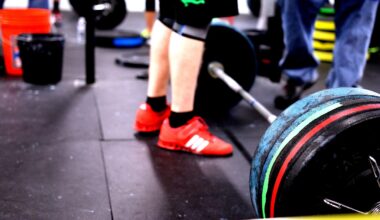Myth: Bigger Muscles Make You Less Flexible
Many fitness enthusiasts believe that having larger muscles decreases flexibility. This myth is prevalent in the fitness community and often discourages individuals from pursuing strength training. In reality, well-structured muscle training can enhance flexibility significantly. To improve flexibility, it is essential to integrate stretching and mobility work into your training routine. Various studies demonstrate a positive correlation between strength training and the capacity to maintain flexibility. The key aspect is the approach to muscle building rather than the size of the muscle itself. Concentrating on a balanced workout that incorporates both strength and flexibility training sets you on a successful path. Additionally, proper techniques should be emphasized to sustain muscle elasticity. Exploring various bodyweight exercises can promote flexibility while also developing muscle. Techniques such as yoga and dynamic stretching are highly effective. Moreover, muscle adapts to the stress placed on it, which can lead to gains in both size and flexibility. Embracing a diverse workout plan allows for optimal performance and prevents the risks of injury. Taking time to learn about both dimensions ensures achieving a well-rounded fitness level, contrary to this misleading myth.
Misunderstanding the relationship between muscle size and flexibility can affect workout choices. Many people fear that bulking up will hinder their agility and movement efficiency. However, larger muscles do not inherently mean lesser flexibility. Flexibility depends on several factors, including muscle length, joint structure, and training regimen. For instance, sports like gymnastics and martial arts showcase athletes with significant muscle mass yet impressive flexibility. Myths often originate from visual stereotypes seen in various sports and the bodybuilding community. It is essential to recognize that muscle size and flexibility aren’t mutually exclusive. Incorporating regular stretching and movement into performance routines can ensure that increased muscle mass doesn’t lead to decreased flexibility. A structured stretching routine can help maintain or even enhance range of motion. Emphasizing various muscle groups when strength training helps create a more balanced physique. For best results, consider varying your workouts to incorporate flexibility-focused exercises. Just remember, bigger muscles can coexist with flexibility. Therefore, maintain an open mind, as adhering to this myth could ultimately limit progress in muscle gain and overall fitness.
Another common misconception is that strength training leads to muscle tightness, which can affect flexibility adversely. While it is true that muscle tightness can occur without adequate care, this does not result solely from lifting weights. Inadequate stretching after workouts can leave muscles in a contracted state, leading to limited mobility. The solution is to combine strength and flexibility training for optimal results. Integrating post-workout stretching can counteract any tightness. Engaging in workouts that incorporate compound movements can help maintain flexibility throughout diverse muscle groups. Consistency is vital in strength training, and including proper stretching movements can enhance benefits. For example, exercises like squats, lunges, and deadlifts develop strength but should always be paired with dynamic stretches. These can elongate the muscles, allowing for improved elasticity. Furthermore, engaging in foam rolling or massage therapy can release muscle tension and enhance recovery. Each workout session is an opportunity to focus on both strength and flexibility enhancement. Therefore, a well-rounded program that suitably balances these components can build bigger muscles without compromising flexibility, debunking this common myth.
The Importance of Training Variety
To effectively counter this myth, it is crucial to adopt a varied training regimen. A training regimen that includes strength, flexibility, and mobility exercises can ensure comprehensive development. Different types of training alter the muscle and connective tissue conditions. For example, weightlifting primarily works the muscle fibers but should always be coupled with activities focusing on range of motion. Engaging in activities, such as yoga or Pilates, can promote flexibility while still allowing for muscle growth. Athletes frequently incorporate diverse training modalities to ensure all aspects of their fitness are addressed. For optimal results, blend strength training with conditioning workouts, such as high-intensity interval training (HIIT) or circuit training. This cross-training approach generates significant muscle adaptations while still prioritizing flexibility. Gradually increasing your range with various stretching techniques prevents stiffness and enhances performance. Moreover, proper warm-ups and cool-downs encourage muscle elasticity. Always listen to your body’s needs and include rest days in your routine for recovery. In summary, diverse training methodologies contribute to both strength and flexibility, making the pursuit of larger muscles a practical goal without rigid compromises.
Let’s consider the significant role of stretching before and after your workouts. Extensive research indicates that pre-workout stretching can enhance flexibility temporarily and reduce the risk of injury. Meanwhile, post-workout stretches actively promote the lengthening of the muscle fibers you’ve just trained. However, some may assume that focusing solely on either strength or flexibility may yield the best results. In reality, these considerations work more effectively when combined rather than being treated as two separate workouts. Incorporating strategies like dynamic stretching pre-workout followed by static stretching can yield great results. This dual-approach aligns muscle growth with increased flexibility and mobility. Furthermore, consider using resistance bands or light weights during your flexibility exercises to enhance the effectiveness of your efforts. Doing so engages the muscles slightly while still promoting elongation. There should be an emphasis on adequate warm-up before any workout, ensuring muscles are prepared for lifting weights. In contrast, proper cool-down and stretches aid in muscle recovery and release. Prioritizing both strength and flexibility is vital for those looking to increase overall performance while mitigating injury—contradicting myths surrounding muscle training.
Flexibility Training is Essential
Flexibility training should never be neglected serious lifters aiming to gain muscle. As muscle fibers grow, the connective tissues can experience tension, leading to tightness if ignored. In fact, just as important as lifting weights is the mobility required throughout various exercises. A dynamic warm-up can significantly enhance blood flow and improve flexibility before challenging your muscle strength. Giving your body the attention it deserves is crucial in maintaining balance. The inclusion of exercises such as yoga or tai chi into your weekly schedule helps improve both muscle gain and overall body resilience. Strength isn’t just about lifting heavier weights but also the ability to unite mind and body effectively. Consider utilizing a foam roller as part of your warm-up or cool-down routines, as it serves to alleviate tight muscles and improve overall flexibility. The journey comprises not only lifting weights, but also caring for the muscles throughout their growth. Your flexibility ultimately impacts performance. Aim to maintain mobility through proper practices, preventing injuries or limitations in your training. Hence, a muscular physique does not hinder flexibility but instead embodies a commitment to balanced growth.
Moreover, recognizing that everyone has different bodies is paramount. Not everyone will experience the same effects from weight training on their flexibility. Genetics, lifestyle choices, and previous physical activity heavily influence individual outcomes. Therefore, custom tailoring your workouts toward both strength and flexibility can yield the best results for you. Monitoring developments through assessments can help identify any discrepancies in flexibility and strength gains. Leveraging techniques such as self-myofascial release can alleviate tight spots that may inhibit performance. Listening to your body and adjusting routines are essential elements of continuous progress. Attempt to maintain an open dialogue with fitness professionals who can assist you in navigating these misconceptions effectively. Explore workshops or resources that focus specifically on muscle gain myths to expand your knowledge. Understanding the intersection of muscles, training, and flexibility will elevate your fitness journey. Ultimately, it is essential to continue emphasizing the importance of balanced workouts and proper recovery. Collaborating these elements creates a solid foundation for enhanced performance while promoting well-rounded growth. Thus, debunking this myth proves vital for those on a mission for serious muscle gain.
In conclusion, dismissing the myth that bigger muscles lead to decreased flexibility is crucial for anyone desiring muscle gains. By incorporating diverse training methodologies and proper stretching techniques, impressive muscle size and flexibility can indeed coexist. Flexibility should never be compromised while focusing on strength development. Instead, recognizing the interdependence between these two components creates a well-rounded fitness profile. Engaging in various exercises fosters continuous improvement, avoiding the pitfalls of misconceptions. Developing a solid plan focusing on maintaining muscle elasticity while building mass is of utmost importance. Achieving flexibility alongside muscle growth can only be realized through intentional training choices and diligent practice. Adapting your routine to include elements expanding your physical capability is vital for sustained improvement. Therefore, embrace this knowledge as you tackle your fitness journey, enhancing your body’s functionality, agility, and overall health. It empowers individuals to pursue both goals without fear. Ultimately, it’s about promoting a balanced approach towards achieving objectives. As you seek to grow stronger, let go of limiting beliefs, and remember—bigger muscles can support, not diminish, flexibility. Redefine your perception of fitness, ensuring that both pursuits are part of your success story.


